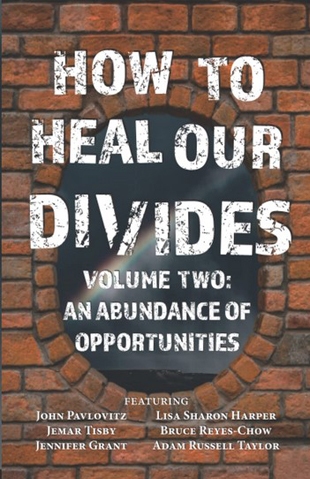This sequel to How to Heal Our Divides: A Practical Guide offers tools, resources, ideas, and places for healing interpersonal divides and our alienation from the earth, our common home.
We appreciated the chapter of Shannon CrossBear, an Ojibwe/Irish storyteller and traditional healer, writing on “WE, the world.” She presents a new consciousness, a new movement (she traces it back to 2004), and a series of organizing principles for building a “We society [which] abandons the thought of 'them' because it is only us.” It is already happening in communities around the world.
Some of the chapters are written for people in organized religion, such as Adam Russell Taylor’s. He is the new president of Sojourners (sojo.net), and writes on “Politically Divided Congregations,” focusing primarily on Christian churches and offering a curriculum “to provide a theological foundation for transformative, faith-inspired engagement in anti-racism and justice work.”
Other chapters, such as the one by Ibrahim Anli, executive director of the Rumi Forum (rumiforum.org), describe work that is intentionally multifaith, interfaith, and not necessarily religious. The Rumi Forum, in the greater Washington, DC area, encourages conversations and mobilizations across the diversity of religious traditions and spiritual expressions.
But there is also great variety here. Children’s author and memoirist Jennifer Grant introduces readers to an organization — Open Books (openbooks.org) — that provides public school libraries “with age-appropriate children’s books in which LGBTQ+ kids can find themselves.” Grant explains why this matters and then, very specifically, how you can become involved.
Spiritual practices abound in the chapter by Jennie A. McLaurin, “Healing After Moral Injury,” which offers practical ways to recognize, honor, and heal from what occurs to all of us at one time or another: “we find ourselves compelled by leaders to act in ways that contradict the values we cherish.” McLaurin utilizes the teachings of Joanna Macy very well in this chapter and its resources. (See the excerpt accompanying this review for one of these sample practices.)
There are twenty-seven such chapters. The final one explores “Healing Divides through Music” -- something we haven’t seen much about in the past. Its authors include Noel Paul Stookey, the singer-songwriter “Paul” from Peter, Paul, and Mary. These authors show, through examples of their organization, Music to Life (musictolife.org), how singing, songwriting, performing, listening, and collaborating are ancient and future tools for bringing people together in a polarizing time.
If you cannot find ways to get involved in making positive change in the world through the resources, ideas, and people of this book, you probably aren’t yet ready to try.
